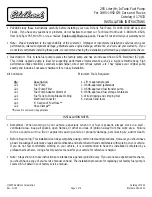
•
Inflation pressure:
A measure of the amount of air in a tire.
•
Standard load:
A class of P-metric or Metric tires designed to carry a
maximum load at set pressure. For example: For P-metric tires 35 psi
(2.4 bar) or 36 (2.5 bar) depending on tire size and for Metric tires
36 psi (2.5 bar). Increasing the inflation pressure beyond this pressure
will not increase the tire capability.
•
Extra load:
A class of P-metric or Metric tires designed to carry a
heavier maximum load at 42 psi (2.9 bar). Increasing the inflation
pressure beyond this pressure will not increase the tire’s load-carrying
capability.
•
kPa:
KiloPascal, a metric unit of air pressure.
•
PSI:
Pounds per square inch, a standard unit of air pressure.
•
Cold tire pressure:
The tire pressure when the vehicle has been
stationary and out of direct sunlight for an hour or more and prior to
the vehicle being driven for 1 mile (1.6 kilometers).
•
Recommended inflation pressure:
The cold inflation pressure found
on the Safety Compliance Certification Label (affixed to either the
door hinge pillar, door-latch post, or the door edge that meets the
door-latch post, next to the driver’s seating position) or Tire Label
located on the B-Pillar or the edge of the driver’s door.
•
B-pillar:
The structural member at the side of the vehicle behind the
front door.
•
Bead area of the tire:
Area of the tire next to the rim.
•
Sidewall of the tire:
Area between the bead area and the tread.
•
Tread area of the tire:
Area of the perimeter of the tire that
contacts the road when mounted on the vehicle.
•
Rim:
The metal support (wheel) for a tire or a tire and tube assembly
upon which the tire beads are seated.
334
Wheels and Tires
2015 Flex
(471)
Owners Guide gf, 1st Printing, October 2014
USA
(fus)
















































